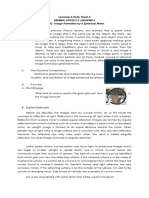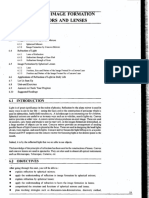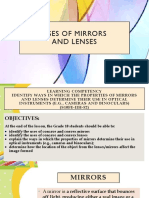E-Content 2
E-Content 2
Uploaded by
Murali SambhuCopyright:
Available Formats
E-Content 2
E-Content 2
Uploaded by
Murali SambhuOriginal Description:
Original Title
Copyright
Available Formats
Share this document
Did you find this document useful?
Is this content inappropriate?
Copyright:
Available Formats
E-Content 2
E-Content 2
Uploaded by
Murali SambhuCopyright:
Available Formats
3.
TOPIC
Laws of reflection
Angle of incidence is equal to angle of reflection
Incidenct ray, reflected ray, nomal all lie in the same plane
Reflecting medium
Involves
Plane mirror Spherical mirror
Reflecting surface is plane
Convex mirror Concave mirror
Image of the same size is obtained
at the same distance from the mirror Reflecting surface Reflecting surface
curved outwards curved Inwards
Image formed is Image may be
small,virtual and small,large,real
inverted or virtual
Uses Uses Uses
3
E-CONTENT DEVELOPMENT OF
LAWS OF REFLECTION
1. HOME
http://www.physicsclassroom.com/
http://www.physics.about.com
Http://www.physics.umm.edu
http://www.physics4kids.com
2. OBJECTIVES
To develop e-content on the topic Laws of reflection
To form the concept of reflection
To form the idea about plane mirror and spherical mirror.
To develop an understanding of Laws of reflection and is applications in real
life situations
1
4
CONCEPTS
1) Plane mirror :- A mirror in which reflecting surface is plane
2) Spherical mirror :- A mirror in which reflecting surface is spherical
3) Convex mirror :- If the reflecting surface is curved outwards
4) Concave mirror :- If the reflecting surface is curved inwards
LAW
LAWS OF REFLECTION :- Angle of incidence is equal to angle of reflection.
Incident ray, reflected ray, normal all lie in the same plane.
SUMMARY
Laws of reflection states about reflection. Reflecting medium are of two types
plane mirror and spherical mirror. A mirror in which reflecting surface is plane is called
plane mirror . . A mirror in which reflecting surface is spherical is called spherical mirror.
spherical mirror are of two types Convex mirror and Concave mirror. A mirror in which
reflecting surface is curved inwards is called concave mirror. A mirror in which
reflecting surface is curved outwards is called is Convex mirror. In the plane mirror image is
obtained at the same distance from the mirror and have the same size. Image formation in
the convex mirror is small, virtual and inverted. In concave mirror image may be small,
large, real and virtual. Laws of reflection states that :- Angle of incidence is equal to angle
of reflection. Incident ray, reflected ray, normal all lie in the same plane. All these mirrors
have many uses in daily life situations. Plane mirror is used to reflect light and view our
face. Convex mirror is used as rearview mirror in a vehicle. In medical field, search light,
telescope Concave mirror is used. Thus the e-content can be conveyed very easily and
clearly to the students. It will definitely motivate them to learn. By using the wide scope of e-
content we can make the teaching learning process more effective.
You might also like
- E - ContentDocument3 pagesE - ContentMurali SambhuNo ratings yet
- Physics Assignment 4Document4 pagesPhysics Assignment 4Bilal HassanNo ratings yet
- q2 Reflection CopyDocument54 pagesq2 Reflection CopyShanika MolejonNo ratings yet
- Light Lesson 1 - MergedDocument94 pagesLight Lesson 1 - Mergedrajesh duaNo ratings yet
- Module 3 Questions-AnsweredDocument7 pagesModule 3 Questions-AnsweredVincee SamsonNo ratings yet
- Assign #1 (Optics)Document3 pagesAssign #1 (Optics)janmariefernandez0No ratings yet
- G10 Q2 L15 Concave and Convex MirrorsDocument26 pagesG10 Q2 L15 Concave and Convex MirrorsYno Miguel CroduaNo ratings yet
- Class 7 MirrorExtra Questions and NotesDocument5 pagesClass 7 MirrorExtra Questions and NotesBaha RoxanneNo ratings yet
- 10 Reflection of LightDocument8 pages10 Reflection of LightMugdhaNo ratings yet
- Learning Plan in Science 10: Unit Topic: Content Standard: Learning CompetenciesDocument13 pagesLearning Plan in Science 10: Unit Topic: Content Standard: Learning Competenciesakoaysijoy100% (1)
- Form 1 Light and OpticsDocument25 pagesForm 1 Light and OpticsZern MegaNo ratings yet
- Light Notes ..Document19 pagesLight Notes ..ASHOK SHARMANo ratings yet
- CH 16 LightDocument3 pagesCH 16 LightNoufal EdappalNo ratings yet
- Class 10 - Chapter 10Document52 pagesClass 10 - Chapter 10Ramya L N100% (1)
- Learning Activity Sheet 4 q4 and ST 2Document14 pagesLearning Activity Sheet 4 q4 and ST 2Daniel Angelo Esquejo ArangoNo ratings yet
- Chapter-9 EnglishDocument49 pagesChapter-9 Englishrohityadavyt2007No ratings yet
- Capstone ProjectDocument29 pagesCapstone ProjectJohn RemzNo ratings yet
- SCIENCE10 Q2 M4 LightsMirrorsandLenses v3-EDITEDDocument22 pagesSCIENCE10 Q2 M4 LightsMirrorsandLenses v3-EDITEDRusty Gabriel Suyom100% (2)
- Unit 6Document33 pagesUnit 6mirdulsahuNo ratings yet
- Shedding Light On Curved MirrorsDocument14 pagesShedding Light On Curved MirrorsEyad Ahmed Hanafy Mahmoud TahaNo ratings yet
- Light Class 10Document7 pagesLight Class 10kaushikrohan22No ratings yet
- Light - AnswersDocument3 pagesLight - AnswersSanyam 1 BNo ratings yet
- Science 10 Quarter 2 Module 4Document6 pagesScience 10 Quarter 2 Module 4Jess Anthony Efondo100% (6)
- Optics 1Document8 pagesOptics 1Stephson Micayee Da LastbornNo ratings yet
- Physics: Nature of Light - Flat MirrorsDocument17 pagesPhysics: Nature of Light - Flat MirrorsReplayableNo ratings yet
- Chapter 9 - Light - Reflection and RefractionDocument4 pagesChapter 9 - Light - Reflection and Refractionsujatalam1921No ratings yet
- Science 10 Quarter 2 - Module 4: Uses of Mirrors and Lenses (REVIEWER)Document4 pagesScience 10 Quarter 2 - Module 4: Uses of Mirrors and Lenses (REVIEWER)Ella AuriaNo ratings yet
- Mirrors and Lenses: Ray Diagrams in A Plane MirrorDocument6 pagesMirrors and Lenses: Ray Diagrams in A Plane MirrorLabeenaNo ratings yet
- Reflection RefreactionDocument90 pagesReflection RefreactionabhishekmishranarayanaNo ratings yet
- PhysicsDocument27 pagesPhysicsshlokpandey0202No ratings yet
- Module 5 1Document35 pagesModule 5 1Rejie Nel AquinoNo ratings yet
- Science 3 4 ReviewerDocument3 pagesScience 3 4 ReviewerAngelica VersolaNo ratings yet
- Application of Optical Instrument LeCtureDocument14 pagesApplication of Optical Instrument LeCtureNURSHAHADAH ISMAELNo ratings yet
- science ch10Document6 pagesscience ch10goranshkhandelwal38No ratings yet
- Science 11.9Document2 pagesScience 11.9준준챤No ratings yet
- Reporting in Science About Curved MirrorsDocument26 pagesReporting in Science About Curved Mirrorsadrian pabyNo ratings yet
- Concave MirrorsDocument24 pagesConcave MirrorsclarisseNo ratings yet
- Formation of Image LDocument24 pagesFormation of Image LTel BiscochoNo ratings yet
- Science10 Q2 Mod4 v4Document11 pagesScience10 Q2 Mod4 v4Kim Taehyung100% (1)
- Mirrors and Lenses ReviewerDocument9 pagesMirrors and Lenses ReviewerVannie MonderoNo ratings yet
- LightDocument38 pagesLightashishjh1987No ratings yet
- The Learners Demonstrate An Understanding of The Images Formed by The Different Types of Mirrors and LensesDocument78 pagesThe Learners Demonstrate An Understanding of The Images Formed by The Different Types of Mirrors and LensesWarren Dela CernaNo ratings yet
- Delhi Public School Nadergul GRADE-10 Physical Science Light - NotesDocument17 pagesDelhi Public School Nadergul GRADE-10 Physical Science Light - Notesbaby doodlesNo ratings yet
- Light Printed NotesDocument6 pagesLight Printed Notesphysicsbooks.storeNo ratings yet
- 2 Navneeta Kunwar Public School Varanasi-1Document12 pages2 Navneeta Kunwar Public School Varanasi-1shashwatraipro1No ratings yet
- LIGHT Physics Form 4Document11 pagesLIGHT Physics Form 4Amrita Kaur100% (1)
- GwenDocument12 pagesGwenChacha CawiliNo ratings yet
- LightDocument250 pagesLightBritney HikelNo ratings yet
- LIGHT NOTES NewDocument7 pagesLIGHT NOTES NewEric ImmanuelNo ratings yet
- Holiday Homework: ScienceDocument19 pagesHoliday Homework: Scienceketavyasingh05No ratings yet
- Paper Mirrors: by Group 6 Dani Anisa Imanda (20129258) Intan Dwi Puspita (20129296) Tiara Utari (20129356)Document13 pagesPaper Mirrors: by Group 6 Dani Anisa Imanda (20129258) Intan Dwi Puspita (20129296) Tiara Utari (20129356)tiara utariNo ratings yet
- Light Physics Class 10 Part 1Document12 pagesLight Physics Class 10 Part 1Kishwar SachanNo ratings yet
- Reflection of Light by Different SurfacesDocument6 pagesReflection of Light by Different SurfacesShaik HidayathullaNo ratings yet
- Chapter - 10 (A) Light and ReflectionDocument12 pagesChapter - 10 (A) Light and ReflectionSuhani Gosain100% (1)
- Wave and Optics DLPDocument8 pagesWave and Optics DLPlopezchinshin28No ratings yet
- Optics Hand OutDocument14 pagesOptics Hand OutChillyung OxytoneNo ratings yet
- Uses-Of-Mirrors-And-Lenses-230218085130-17383ef5 2Document27 pagesUses-Of-Mirrors-And-Lenses-230218085130-17383ef5 2Marie Antoinette TordaNo ratings yet
- Uses of Mirrors and LensesDocument27 pagesUses of Mirrors and LensesRivera Sofia QueishaNo ratings yet
- How to Build a Digital Microscope: Construct a Reliable, Inexpensive Microscope for both Regular and Polarized Light MicroscopyFrom EverandHow to Build a Digital Microscope: Construct a Reliable, Inexpensive Microscope for both Regular and Polarized Light MicroscopyNo ratings yet
- Article: National Human Rights Commission of IndiaDocument5 pagesArticle: National Human Rights Commission of IndiaMurali SambhuNo ratings yet
- Sasthamkotta Lake Before & AfterDocument3 pagesSasthamkotta Lake Before & AfterMurali SambhuNo ratings yet
- Periodic TableDocument7 pagesPeriodic TableMurali SambhuNo ratings yet
- E-Content 3Document1 pageE-Content 3Murali SambhuNo ratings yet
- Online AssignmentDocument6 pagesOnline AssignmentMurali SambhuNo ratings yet
- Consumer EducationDocument1 pageConsumer EducationMurali SambhuNo ratings yet
- ConsumerDocument1 pageConsumerMurali SambhuNo ratings yet
- Functions of MarketingDocument1 pageFunctions of MarketingMurali SambhuNo ratings yet
- Formatted: Top: (Thin-Thick Small Gap, AutoDocument9 pagesFormatted: Top: (Thin-Thick Small Gap, AutoMurali SambhuNo ratings yet
- Online AssignmentDocument6 pagesOnline AssignmentMurali SambhuNo ratings yet
- Online Assignment: TOPIC: Informal Learning ContextsDocument8 pagesOnline Assignment: TOPIC: Informal Learning ContextsMurali SambhuNo ratings yet
- Lesson Template (Changes) : Curriculum StatementDocument8 pagesLesson Template (Changes) : Curriculum StatementMurali SambhuNo ratings yet







































































